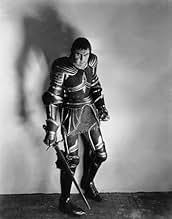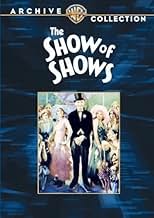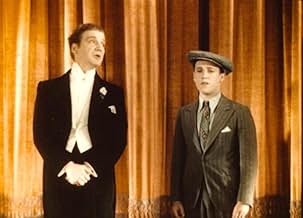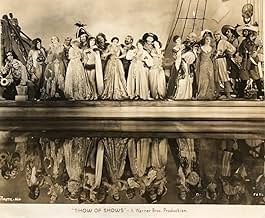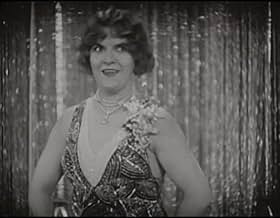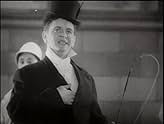Adicionar um enredo no seu idiomaIn 1929, the studio gave the cinema its voice and offered audiences a chance to hear their favorite actors and actresses from the silent-screen era. For the first time, they can be heard in ... Ler tudoIn 1929, the studio gave the cinema its voice and offered audiences a chance to hear their favorite actors and actresses from the silent-screen era. For the first time, they can be heard in a gaudy, grandiose musical-comedy revue. But also appearing are actors and actresses from ... Ler tudoIn 1929, the studio gave the cinema its voice and offered audiences a chance to hear their favorite actors and actresses from the silent-screen era. For the first time, they can be heard in a gaudy, grandiose musical-comedy revue. But also appearing are actors and actresses from the first 'talkies', stars from Broadway, and, of course, German shepherd Rin-Tin-Tin. Fra... Ler tudo
- Direção
- Roteiristas
- Artistas
- Prêmios
- 2 vitórias no total
- Performer in 'Meet My Sister' Number
- (as Mimi Vendrell)
- Joe Burke
- (as Joe Burke)
- Direção
- Roteiristas
- Elenco e equipe completos
- Produção, bilheteria e muito mais no IMDbPro
Avaliações em destaque
The movie is quite a spectacle, though nowadays its value is mostly as a curiosity for hardcore film buffs. The songs generally aren't that great and the performances aren't always polished, though everybody seems to be having fun. Much of the cast is made up of largely forgotten stars of the late silent/early sound era that most modern viewers wouldn't recognize. But it's a real treat for film historians.
I'm a big fan of old movies and classic Hollywood, and many of the featured stars are obscure even to me. Most of the stars are identified at some point in the film, though countless others are mixed into scenes with little fanfare. Without identification I was able to spot Myrna Loy, Ben Turpin, Chester Morris, Richard Barthelmess, Douglas Fairbanks Jr., John Barrymore, and Monte Blue. And I'm familiar, to varying degrees, with people like Frank Fay, Winnie Lightner, Louise Fazenda, Dolores Costello, Noah Beery, and Tully Marshall.
Frank Fay emcees the proceedings, tying the various acts together and introducing the stars. His verbal comedy shtick is a good fit for talkies and he does a pretty good job.
An early highlight is Winnie Lightner's upbeat comedy song "Ping Pongo". Louise Fazenda, Fay, Lloyd Hamilton, and Beatrice Lillie do a recitation sketch that's pretty funny, though it stretches a little too long. There's a number featuring notable screen villains as pirate versions of themselves (singing pirates, naturally). Another features several pairs of movie star sisters, including Loretta Young and Sally Blane, who look freakishly alike. Lightner also sings "Singin' in the Bathtub", a tune I know from old Looney Tunes cartoons. John Barrymore hams it up with a Shakespeare soliloquy as Richard III.
I was surprised and delighted halfway through to see an exotic number in two-strip Technicolor. Apparently most of the film was shot in color, but the surviving print is in black & white with the exception of this segment.
It's great seeing so many Hollywood personalities doing fun little acts and musical numbers. Everybody seems to be having a good time, putting on a big show. Some names and faces are more recognizable than others, but the film is a fascinating glimpse at the stable of Warner Bros. talent at this transitional point in cinema history.
A musical spectacular from the infancy of the sound era, THE SHOW OF SHOWS is literally presented as a stage production, with fairly static cameras and sometimes clunky framing. Sometimes the closed stage curtain fills the top three-quarters of the frame while a chorus line dances along the bottom edge. In one song voices drop out of range of the microphone as the singers move across the stage. Some of the extended crowd choreography gets tiresome, but the comedy is good for a few laughs. And it's always fun trying to identify the stars in the ensemble scenes.
6/10 for entertainment value, but 7/10 as a historical curiosity.
Generally superior, I think, to MGM's "Hollywood Revue of 1929," and worth watching if you can
Você sabia?
- CuriosidadesAt its New York City premiere at the Winter Garden Theatre, some musical numbers were projected on a larger, wider screen by a system called Magnascope, which had been in occasional use since 1924.
- Citações
Executioner - Guillotine Sequence: Prologue is Dead! On with the Show of Shows!
- ConexõesFeatured in The Voice That Thrilled the World (1943)
Principais escolhas
- How long is Show of Shows?Fornecido pela Alexa
Detalhes
- Data de lançamento
- País de origem
- Idiomas
- Também conhecido como
- Show of Shows
- Locações de filme
- Empresa de produção
- Consulte mais créditos da empresa na IMDbPro
Bilheteria
- Orçamento
- US$ 850.000 (estimativa)
- Tempo de duração
- 2 h 8 min(128 min)

